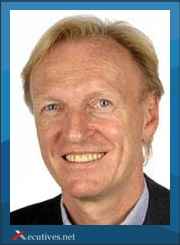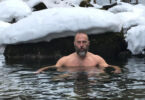Andreas M. Bertram, born 1954, is a skilled physical therapist and has devoted himself to the subject of physiotherapy field for many years, not only as a practitioner, but also as an author and researcher. Together with his wife, Christina, he runs a physical- and occupational therapy/hand-rehabilitation practice in Basel as well as a medical fitness center. In his interview with Christian Dueblin, Andreas Bertram speaks about the physical therapy profession, about stress and its effects on the body, about the physical requirements for elite sports and about the lack of exercise among children.
Dueblin: Mr. Bertram, you are among the most experienced physical therapists in Switzerland and run your own physical and occupational therapy/hand rehabilitation practice in Basel. It is my impression that physical therapy was a fashionable career 20 years ago but has developed into a science today. From your point of view, what has changed in physical therapy over the last two decades?
Andreas M. Bertram: Your observation is correct. In the 70’s and 80’s, physical therapy was an „in“ profession. Reasons for this include its relation to medicine and to sport, as well as physical activity in general. Furthermore, the training does not last nearly as long as a medical degree. Many who would like to work with people in the health sector find the ideal mixture in a physical therapy career. The numerous changes that have taken place in this profession over the last two decades are largely due to research. Many physical therapists today are actively involved in research projects. In the past, this was considered a matter for medical doctors and excluded members of our profession. Today more and more physical therapists are approaching our field with their own questions and specialized knowledge. This development has been happening worldwide. In this regard other countries have been ahead of us for a long time. Australia and New Zealand, for instance, have been doing physiotherapy research for many years. Professional competition has become intense and cost-saving measures in the health sector have, in the last several years, taken on grotesque proportions. In order to survive, the field of physical therapy had no other choice but to develop itself further scientifically. This meant that the professional education and training also had to be changed. In Switzerland today you can get Bachelor’s and Master’s Degrees in physical therapy. These are important milestones. Our profession has become an academic discipline. In the USA and also in the Netherlands and Belgium, physical therapy requires a university degree. In Switzerland, however, we haven’t yet reached that point.
Dueblin: Are elite sports partially responsible for the current status of physical therapy? There are many athletes today who could probably no longer function without physical therapy.
Andreas M. Bertram: The application of physical therapy in elite sports is more the result of therapeutically scientific findings in recent years. Elite sports without physiotherapeutic knowledge and treatment is truly unimaginable today. People who practice elite sports and, in doing so, stress their bodies enormously, are dependent on specialist counsel and treatment from our profession. Naturally this has focused particular attention on our field.
Dueblin: People are getting older, want to stay mobile and, therefore, also need their bodies longer. How do you see this development in connection with physical therapy?
Andreas M. Bertram: Life’s requirements have clearly changed. In the past, one was old at 70, had to accept physical disabilities as fate and come to terms with them. Today, due to great advances in medicine, elderly people are very mobile and even active in sports. They have the possibility to overcome an illness and, afterwards, become active and mobile again. Medical science today offers very different possibilities for the system than 20 years ago; for example for hips, backs or knees. Hip and knee operations are even carried out in very elderly people. Many 70-year-olds today can play golf or jog after such operations. Spinal operations are also standard in medicine today.
Not only medicine has facilitated and enabled the elderly to move and stay mobile, however. Increasing numbers of people are building up health reserves through activities. These have a positive effect on aging. As we know, more and more cells die as we age. People who keep their bodies fit, start this cell reduction from a much higher level. There are more cells and muscles and, therefore, the noticeable effects of this process are delayed. Staying physically fit can be seen as a sort of „fountain of youth“. This development has also changed the patient structure of physical therapists.
Dueblin: For me, the term physical therapy has often had a connection to ski- or sporting accidents. Do people also go to physical therapy as a preventive measure?
Andreas M. Bertram: People primarily come to us with an acute or latent health problem. Physiotherapy practices usually get their patients referred by the attending physicians and the treatment is covered by the health insurance. However, there are indeed increasing numbers of people, companies and supervisors, who don’t wish to, or cannot afford to, get sick and therefore come to us preventively. We show them what they can do at work for their health, for example in the way they sit and stand. Many people come because they have neglected their health and want to change. We offer consultancy and coaching to help them attain their goals.

Andreas M. Bertram and Wolfgang Laube: Sensomotorische Koordination. ISBN 9783131437914. By courtesy of Mr. Bertram
Dueblin: Many people today are under extreme stress. You spoke of managers wanting to take preventive measures. How would you judge the stress factor in your work? Is stress a reason that people need physical therapy treatment?
Andreas M. Bertram: Stress has effects on the body: it can impair metabolism and cause illness. Adrenaline is largely responsible for these negative effects. Adrenaline is one of many hormones essential for survival. Our ancestors needed adrenaline for encounters with dangerous animals, for example. They needed to react quickly: fight or flight. This required immediate and maximum muscular performance. Our muscles, however, are not designed for this. Adrenaline helps us to release a surge of otherwise impossible power in a fraction of a second. The goal and result of adrenaline release is intensive muscular activity. Physiologically, through muscular activity, adrenaline is broken down again. This process is biologically and chemically quite interesting. Through muscular activity the body regains its chemical balance. Metabolically, people today are very much the same as thousands of years ago: in the Stone Age, for instance. Every type of stress releases adrenaline, whether it’s caused by a conflict on the job, relationship or family problems, or just life in general. So every day, depending on the stress, we experience releases of adrenaline. The difference today is that, in our society, it has become increasingly difficult to reduce the adrenaline levels again. In stress situations, we are, so to speak, stuck sitting on our adrenaline. Strictly speaking, we would have to use our muscles in stress situations. Biologists and physicians attribute the pathogenic effects of stress to this not being done. It is commonly referred to as a lifestyle disease.
Dueblin: So consequently, there is something to be said for companies setting up fitness centers for their employees to use.
Andreas M. Bertram: There are many companies which do just that. The results are mostly positive, except that the people who should use the fitness center are not always the ones taking advantage of it. By all means it is worthwhile to develop exercise programs and put them into effect, but it doesn’t necessarily have to be a fitness center. Companies often offer more spa-type resources than programs to reduce stress, and fitness-centers can also be dangerous. If one is instructed poorly and trains incorrectly, this can lead to health problems. I’ve often seen people full-pumped with adrenaline, go to a fitness center and do harmful exercises. Quite often these people are filled with motivation and good intentions but train with too much weight and damage their tendons and ligaments. This leads to the typical sport injuries we deal with in physical therapy. Further damage can be caused when cardiovascular training is over-done. As you can see, a fitness center alone is not enough: you need proper instruction and supervision to achieve optimal results.
Dueblin: What are the most typical stress symptoms that you are confronted with in physical therapy?
Andreas M. Bertram: In our practice we see mostly muscle pain and tension. We normally treat neck, shoulder and back pain. Stress can also cause headaches, tinitus or pains shooting down the leg. If these symptoms are caused by stress, and one ignores them, they can lead to exhaustion or depression. In extreme cases, this can cause burnout. Prior to their burnout, patients usually experienced severe stress situations and reacted too late or not at all.
Dueblin: So it seems that with physical activity one can avoid or at least diffuse some of the illnesses and problems which you’ve discussed. Often sitting or standing posture at work is the culprit. Everyone who sits at a computer for several hours a day has experienced neck tension.
Andreas M. Bertram: That’s true. You hear more and more today about ergonomics in the workplace. We ran ergonomic training courses for the pilots and flight attendants of the former airline „Crossair“. I accompanied the crew on flights and, based on the observations made, we recommended corrective measures which had a very positive effect on the crew. We developed correct vs. incorrect movement patterns and showed them motion sequences which are good for the body. These dealt mostly with bending down, pushing and the long hours of sitting for the pilots. We’ve been doing something similar for the last two years with a public transportation company. Bus and tram drivers are constantly exposed to stress situations in daily traffic. Many of them were complaining of back pain and wanted to do something preventively about it. As a result, we have developed a training program and exercises which they can do safely while driving. In addition, these exercises also help them stay alert. We have also taught them exercises which they can do at the bus/tram stops. These are all essentially designed to activate the muscles and break down adrenaline. I’ve mentioned this to show that a great deal can be achieved with relatively small changes and with awareness training.

Picture from: Andreas M. Bertram und Wolfgang Laube: Sensomotorische Koordination. ISBN 9783131437914. By courtesy of Mr. Bertram
Dueblin: The Spanish cyclist Indurain was considered exceptionally gifted. After many measurements and various analyses, it was determined that he had the perfect build for cycling. Similar things have been said about Roger Federer, the tennis player. What is it exactly that differentiates these people from others and enables them to achieve superior results?
Andreas M. Bertram: A person’s physical predisposition is important. There are anatomical requirements for peak-performance in sports, without which a person can never get to the top. Only people who fulfill these anatomical requirements are able to generate the necessary physical strength that is needed in elite sports. Today people who have what it takes to become professional are recognized and selected at a very early age. There are only slight differences within this selected group. If you watch Federer’s movements, you can see that his complete motion sequences are very round, aesthetic and enjoyable to watch. Not only is this perfect motion sequence the result of his anatomical proportions, but also his sensorimotor coordination. Federer has a particularly great ability to program and call up the specific motion sequences for tennis, so that all of the required bio-mechanical forces can be activated. The result is maximum performance. That is why I believe slight deviations in his build to be inconsequential. His timing is perfect. The determining factor is the cooperation between the brain and muscles: so more a neuromuscular component than a purely proportional one. But of course, proportions are an essential requirement.
Dueblin: Such people are coached and trained at a very young age. Time and again you read about the many young athletes who get health problems and eventually „fry“ their bodies. As a physical therapist, what are your thoughts on this?
Andreas M. Bertram: That is indeed a big problem that concerns us. When the body is growing, training stimuli also cause growth stimuli. When a child trains in a one-sided sport, their growing body will be changed by the sport-specific forces acting on the child and can cause asymmetric growth. In a child who plays tennis, this can mean one arm and shoulder will be proportionally larger due to the intense training stimulus. This is often evident just by looking at their body. Because of this, many young athletes need physical therapy treatment. However, I see another problem that arises much more frequently and has more harmful effects on health, particularly since there is a very small percentage of children who do too much, compared to a very large percentage who move far less than they should, with detrimental effects on their bodies. Besides, young athletes often practice complimentary training regimes, since we are aware of the problem. In larger cities we have the problem that our transportation network is too efficient. Almost everyone has a car and there’s a bus stop on every corner. Children don’t ride bicycles as often as they used to; they are chauffeured. Physical education classes can’t make up for that. These children’s agility also suffers. Kindergarten teachers often complain that children today are no longer able to sack-race, stand on one leg or do a somersault. This creates great challenges for physical therapists. People who do not learn how to use and develop their sensorium as children or adolescents are not as capable of mastering dangerous situations such as tripping or falling when they are older. They stumble more easily and thereby injure themselves more frequently. So when it comes to physical capabilities and skill, these children will have serious problems in old age.
We have also seen that, to a certain extent, mental fitness goes hand-in–hand with physical fitness. It is believed that, through physical exercise our metabolism functions at a higher level and endorphins are released. This is commonly known as “runner’s high”. These endorphins inspire and motivate us. When you are motivated, you have a different emotional view of what you want to achieve. This even affects our brain frequencies. Brain researchers have been able to prove that someone who is more motivated has the optimal brain frequencies for using their brain as a high capacity organ. Today we know the concentration phases in which our brains function; for instance when asleep or when concentrating intensely. We also know that there are optimal brain frequencies in which our receptivity and memory are better. Under stress, these frequencies suffer significantly. Memorizing becomes much more difficult, or even impossible. With the help of brain researchers we’ve further been able to prove that different brain frequencies are needed when standing on a balance board as when standing on the floor. On the balance board, the synchronization of both halves of the brain is very close. So on the balance board, you are, in a sense, master of your brain and can achieve a better cognitive performance.
This shows that there is a clear connection between movement and the brain. Various studies are being planned designed to examine the efficiency of children who work standing on a balance board.
Dueblin: Mr. Bertram, thank you very much for this conversation. I wish you continued success with your projects and activities.
Translation from German into English by Andrea Dannegger, Allschwil. (C) 2009 by Christian Dueblin. All rights reserved. Other publications require the author’s explicit consent.







